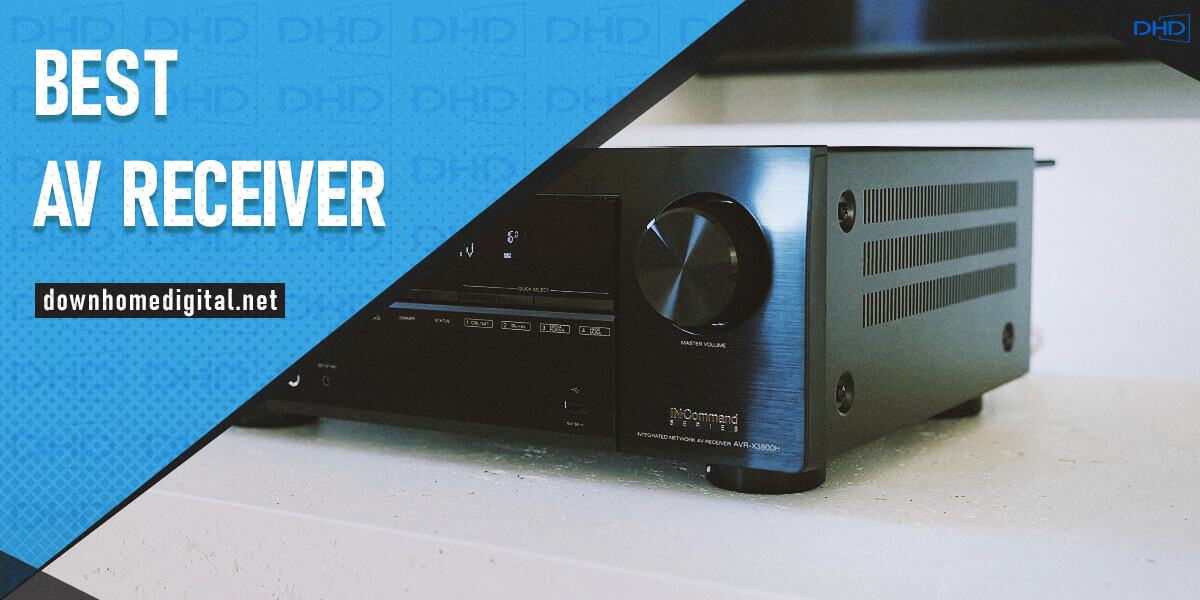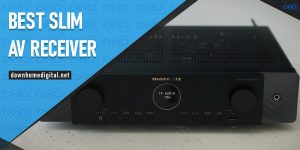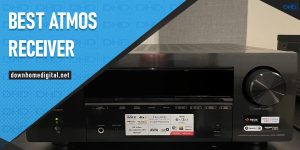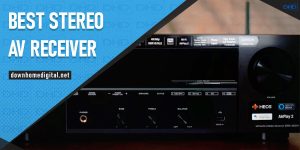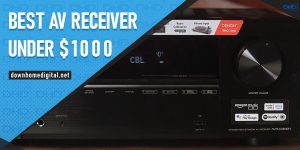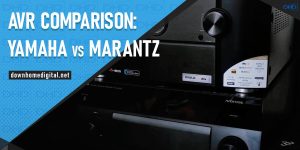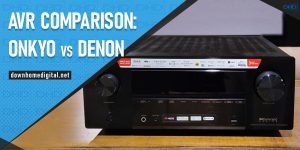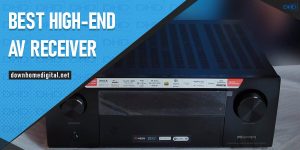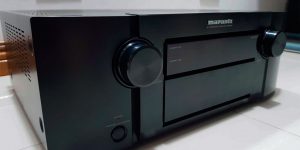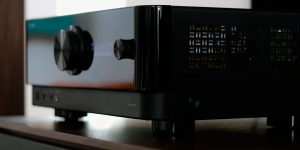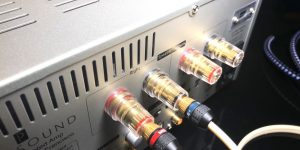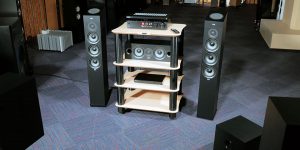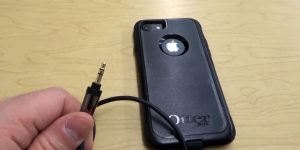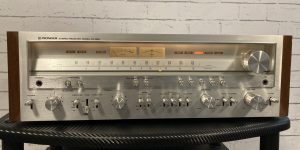The receiver is not the only home theater component gaining popularity today but is undoubtedly its main device because it unites all the others. It connects all the other components, and the quality of signal transmission and the final result depends on it to a large extent. You should pay maximum attention to its choice, and to make this task easier for you, I have prepared an article about the best AV receivers. For convenience, I have categorized the reviews by price rank, so it will be easier for you to navigate the review based on your budget.
Good receivers don’t have to be expensive, although the latter offers more options. After reading this detailed review, you will easily orient yourself on what criteria to pay attention to when buying an AVR and whether your equipment will be able to work correctly with it. Each model on my list has been tested, and they are all worthy representatives of their price rank. I am sure that among them, you will definitely find one that will serve you for many years, pleasing you with unforgettable impressions from watching movies.
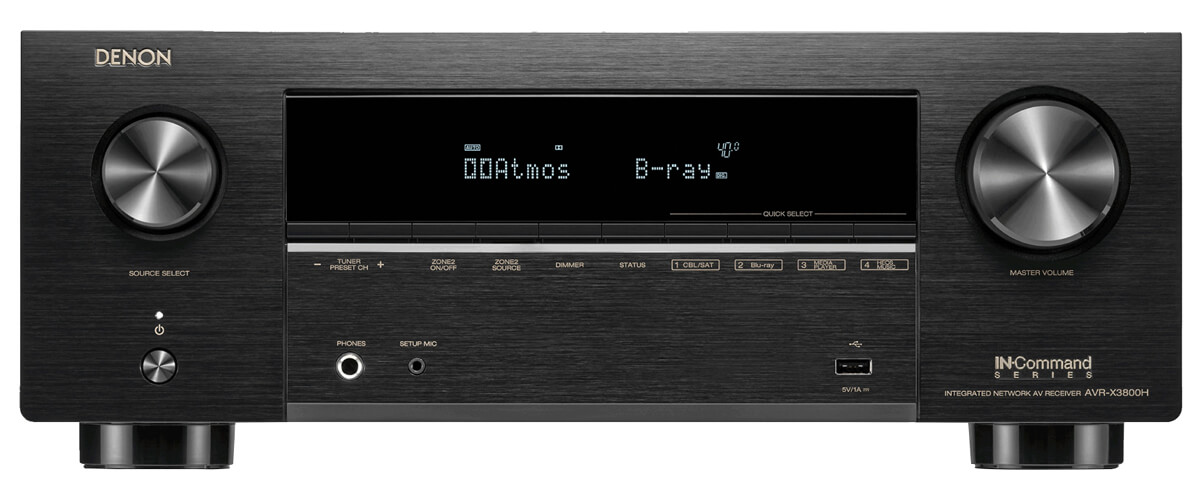
AV receivers comparison table
| Name | Channels | Power output | HDMI in/out | Bluetooth/Wi-Fi | Review |
|---|---|---|---|---|---|
| Denon AVR-X3800H best overall | 9.4 | 105W/8 Ohm, 135W/6 Ohm | 6/2 | yes/yes | Review |
| Marantz Cinema 60 also great | 7.2 | 100W/8 Ohm, 140W/6 Ohm | 6/2 | yes/yes | Review |
| Sony STR-DH790 budget | 7.2 | 145W/6 Ohm | 4/1 | yes/no | Review |
| Yamaha RX-V385 entry-level AVR | 5.1 | 100W/8 Ohm, 70W/6 Ohm | 4/1 | yes/no | Review |
| Denon DRA-800H stereo | 2.2 | 100W/8 Ohm, 120W/6 Ohm | 5/1 | yes/yes | Review |
| Marantz SR8015 premium | 11.2 | 140W/8 Ohm, 175W/6 Ohm | 8/3 | yes/yes | Review |
Best AV receiver reviews
Best mid-priced receivers
In this category, you will find the most optimal price/quality ratio top AV receivers 2025. Mid-range devices can provide almost all currently available modern features and capabilities because they have enough channels to create surround sound, including the ability to add overhead speakers for an even more realistic immersion in the visual content. Such devices also support 4K resolution and a high frame rate of 120 Hz (sometimes even 8K video formats), HDR quality, and support for Dolby Atmos, DTS:X, and other modern surround sound formats. They also have plenty of connectivity options, including HDMI In/Out, inputs for connecting analog and digital devices of an old and new type, phono inputs for connecting turntables, and wireless connections for using streaming services and voice assistants. You can also often find Multi-zone audio and much more.
Let’s not waste any time and get to know my first guest, a representative of a well-established brand. Stock up on popcorn, we are starting our virtual journey into the world of audio and video.
Denon AVR-X3800H – best overall

The leader in this category is the Denon AVR-X3800H 9.4-channel receiver, introduced by the company in 2022. This brand’s products are often winners in my picks because Denon creates AVRs with an optimal price/quality ratio. Having recently merged with the elite Marantz, the company produces the most similar models in terms of options and capabilities while maintaining a reasonable price. At the same time, regarding the quality of internal components, the brand’s receivers are far superior to the rest of the competition. You can always rely on the sound quality, which will not decline over the years, and therefore, you cannot lose by choosing equipment from this brand.
The only drawback for me is the unassuming appearance of the AVR-X3800H compared to other representatives of the mid-price segment of my review. Denon never bothers with a design like Marantz and Yamaha do (the main competitors in terms of quality), but most likely, this helps the brand remain affordable (well, relatively so). But the receiver does well with its internal components, which affect not only the sound but also how long it will last, even under heavy use. Otherwise, everything else is standard, but I’m not crazy about the narrow buttons right below the LCD. As I pressed them, I got all over the glass. Still, it’s less nightmarish than the Yamaha RX-A2A’s fully glossy case. And the LCD is bright and large (look at the Marantz Cinema 60; you can’t see anything on the LCD). And I conclude that simplicity is sometimes more comfortable, even though it’s unsightly.

It has great connectivity, which includes 5 Analog In, 2 Optical and Coaxial (Digital) In, and 1 Phono (MM) In. Thanks to them you can connect all kinds of devices for listening to music, watching movies and vinyl player. But most importantly, it has 4 independent Subwoofers Out and up to 11.4 channel expansion options. This is simply excellent, as this optionality extends the life of the device and enhances future upgrade possibilities. You can also split the audio signal into 2 Zones or use the HEOS Wireless Multi-Room Technology for use in different rooms of your home. USB, AM/FM Tuner, Wi-Fi, and Bluetooth are standard for this category, where the latter two allow you to use streaming services (AirPlay 2, TuneIn, Spotify Connect, Pandora, SiriusXM, Roon Tested) and voice assistants (Alexa, Google Voice Assistant, Apple HomePod).
The Denon AVR-X3800H has 6 HDMI inputs, each supporting 8K/60Hz and 4K/120Hz resolution, and 3 HDMI outs (HDCP 2.3, ARC, eARC) with 8K upscaling and 3D signal Pass-through options. And in this category, that’s the optimal number multiplied by version 2.1. So you have Dolby Vision, HDR10+, and HLG video formats available. At the same time, the range of audio formats that the receiver supports is amazing. Here DTS:X, DTS HD Master, DTS Neural:X, Dolby TrueHD, Dolby Atmos, and IMAX Enhanced and Auro 3D (neither Yamaha RX-A2A nor Marantz Cinema 60 decodes it).
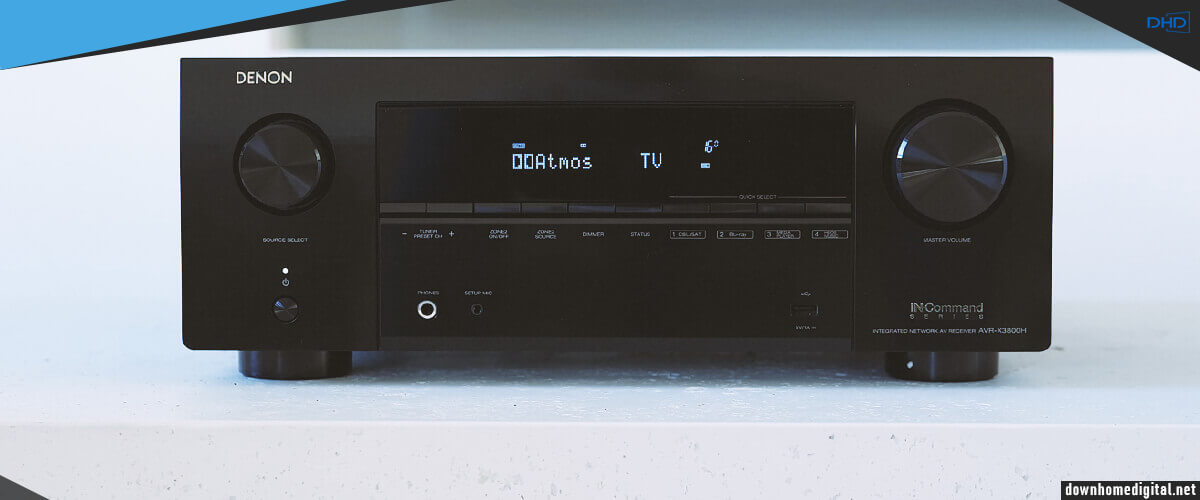
The Denon AVR-X3800H offers an incredibly warm sound, typical of the brand. As for the power, the specifications state 105W (8 ohms, 20Hz – 20kHz, 0.08% 2ch Drive). Given the excellent THD, you can crank the volume to the max without fear of interference. But taking into account the possibility of expanding the system up to 11 channels, such power is not enough (premium 11-channel Marantz SR8015 and Denon AVR-X6700H have 140 W each, which is what a large system needs). Nevertheless, watching the movie Kingsman immersed me in the spy world, making me deflect objects flying across the screen during spectacular fights. It’s very realistic, quite clean, and, of course, stunningly voluminous. AVR-X3800H keeps an excellent balance; each sound wave reaches the right point in space, and I never once observed desynchronization or even the slightest delay.
As for stereo, I adore Denon for its versatility (not all receivers can handle surround sound and stereo at the same level). This time, it was a record by Fleetwood Mac, and it was a delight, as the warmth and dynamics of the brand gave the vinyl the right tone for me. The wireless connection also performed to a high standard. But since you’re saving to buy the AVR-X3800H (if you’re comparing it to premium models), I highly suggest you don’t skimp on the speakers.
I chose the narrow ELAC Debut 2.0 F5.2 front towers for testing, and they gave me an excellent blend and clarity when paired with our receiver. These mid-range speakers don’t require complicated installation and setup for the inexperienced listener but sound on par with more expensive speakers. The soundstage is rich, with pronounced highs and midrange. But for maximum enjoyment, add subwoofers (you can add 4 to the AVR-X3800H!), and this pair will have you dancing to techno, rave, hip-hop, or rock. What’s your favorite? They can handle any genre.
So, in my estimation, the Denon AVR-X3800H is the best AV receiver 2023 in the mid-range class. 9 channels of amplification with the ability to expand the system to 11 channels, plus the ability to connect 4 subs, makes it incredibly adaptable for any user. The only thing it loses to premium brands with 11 channels (Marantz SR8015 and Denon AVR-X6700H) is power. But friends, you are saving significantly when buying it. I advise buying good speakers, and you won’t notice the difference.
The receiver also owns version 2.1 on all HDMI ports and upscaling to 8K. And if you’re a fan of all-in-one systems, its warm, bright sound is great for movies and music of any genre. Read on for my review, and you’ll realize that this AVR is an absolute winner, combining the functionality and quality of more expensive versions at a lower cost.
| Power |
|
| HDMI features |
|
| Video features |
|
| Network |
|
| Surround sound processing |
|
Pros
- The optimal combination of price/quality in the category.
- Clear, quite powerful, and warm sound.
- Expandable up to 11.4 channels.
- Wide range of wired and wireless device connectivity options.
- Optimal number of HDMI ports with 8K support.
- Support for the latest formats, including Auro 3D.
- Ability to use many streaming services and voice assistants.
Cons
- The power is a little low for a large system.
Marantz Cinema 60 – also great
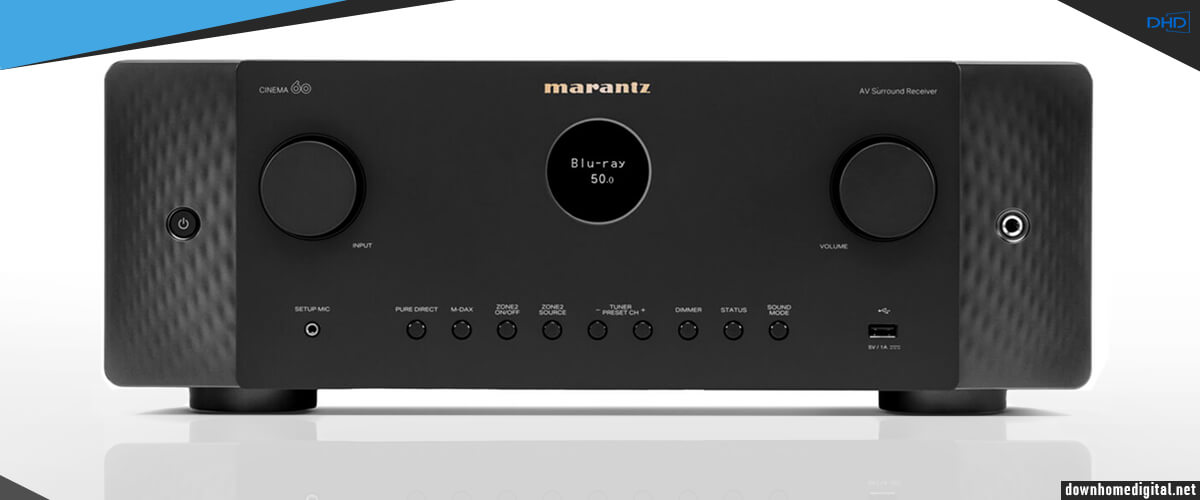
Next on my list comes also a great 7.2-channel mid-range receiver, the Marantz Cinema 60, released in 2022. More similar to the Yamaha RX-A2A but closer in cost to the Denon AVR-X3800H, it has a stunning exterior and great data, along with Marantz’s impeccable quality that puts it in the ranks of best home theater receiver.
Externally, of course, you can immediately see that Cinema 60 belongs to the elite class. Perfumed side panels, a beautiful small round screen in the center, and the buttons are pressed so softly and clearly that I would recommend it to those with frayed nerves as a sedative. But I’ll honestly admit that I don’t love this LCD in the updated Marantz lineup, as you can’t see anything on it. Sure, you have on-screen menus, but I prefer the old format of communicating with the tech when I see that the receiver has reacted to what I’ve commanded. But the main “fat” is on the inside, as evidenced by the 24 pounds of net weight (for comparison, the Denon AVR-X3800H weighs in at 27.6 pounds, and it has more amps, after all). This is what makes a 7-channel AVR so expensive (more than the Yamaha RX-A2A, also with 7 channels of amplification). Any brand receiver will last you as long as you want it to.
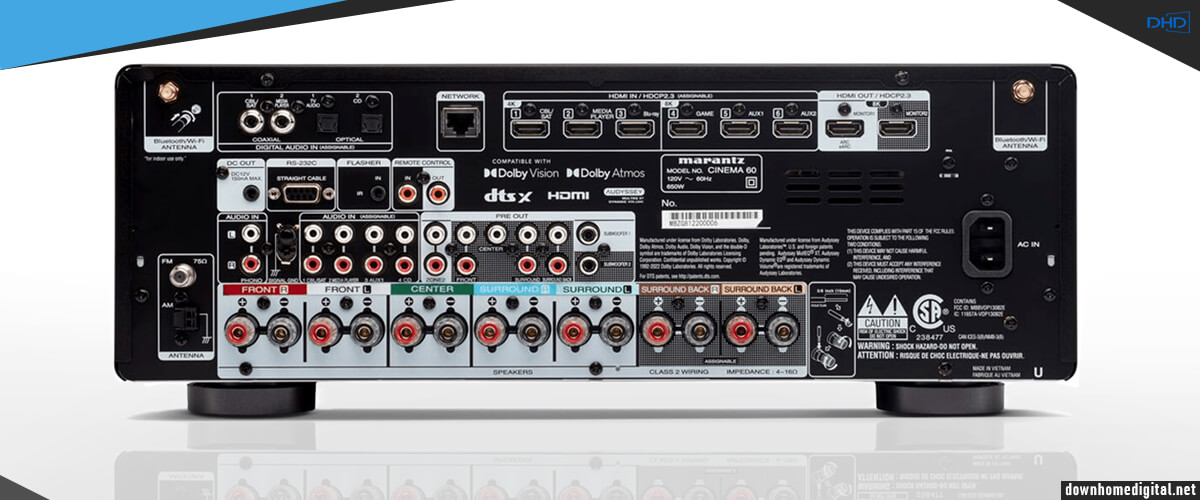
The Cinema 60 has no Composite or Component inputs. Still, it does have 4 Digital In (2 Optical and 2 Coaxial), Phono (MM) In, and 2 Subwoofer Out (these are what make it a 7.2-channel receiver) and 1 USB on the front panel. In addition, HEOS Multi-Room Integrated, AM/FM Tuner, and Wi-Fi with Bluetooth are available. Like the other two in this category, the receiver also works with voice assistance (Alexa, Google Voice Assistant, Apple HomePod) and streaming services (AirPlay Audio Streaming, AirPlay 2, Spotify, Pandora, and others).
Marantz Cinema 60 has 6 HDMI inputs supporting 8K/60Hz (but only 3 HDMI inputs support 8K video), 4K/120Hz, Upscaling 1080P/4K to 8K resolution, and 2 HDMI outputs (HDCP2.3, ARC, eARC). Works with HDR, HLG, Dolby Vision, HDR10+, and Dynamic HDR video content. Audio format decoding is available for DTS HD Master, DTS:X, Dolby TrueHD, Dolby Atmos, and their configurations. In this area, the receiver is more similar to its predecessor, the AVR-X3800H, offering fairly high-quality upscaling to 8K, unlike the Yamaha RX-A2A, which can only upscale video quality to 4K. However, the Cinema 60 is not as good at this feature. Almost every video had brief but noticeable delays or pixelation.

Marantz has its own unique sound that has many fans. This model has similar power capabilities to its predecessors with 100W (8 ohms, 20Hz – 20kHz, 0.08% 2ch Drive), as you can see, with the same low THD. In testing (this time by the wonderful comedy Red Notice with a great soundtrack), it performed well, demonstrating high-quality realistic surround sound. I felt like I was in the center of the action and even bounced in my chair a few times; since the studio for testing the 7-channel system was chosen to be smaller (about 200 square feet), the AVR’s power was enough for me. But I wasn’t surprised at all. When the most prestigious brand puts the word Cinema in a model name, you should expect a receiver simply made for movies.
This time I tested the stereo with AirPlay 2, and it was excellent. Clean, high notes, distinct midrange, and deep bass – excellent quality. The only downside is the paid Audyssey MultEQ Editor app.
If you’re not a fan of complex multi-channel systems but are willing to pay for years of quality, the Marantz Cinema 60 may be an excellent choice. The receiver offers 7.2 channels of surround sound amplification at 100 watts of power, making it a beast in a small room (up to 200 square feet). It’s also enough to watch movies with Dolby Atmos or DTS:X sound. Given its versatility (sounds great in video and music), support for a host of wireless technologies, high-quality internal components, and guaranteed durability – it’s worth every penny invested in it.
Sure, the price may not seem sweet (it’s almost identical to the 9-channel AVR-X3800H), but paying for what you can’t see makes a big difference to the quality of your audio signal (take the unique Current Feedback Topology and HDAM (Hyper Dynamic Amplifier Module), for example). Nevertheless, you have an alternative: a less expensive Yamaha RX-A2A. Let’s move on to it.
| Power |
|
| HDMI features |
|
| Video features |
|
| Network |
|
| Surround sound processing |
|
Pros
- The great sound quality in any format.
- There is an upscaling to 8K, unlike the Yamaha RX-A2A.
- Superior quality construction details.
- Support for modern audio and video formats.
- Marantz’s unique Current Feedback Topology and HDAM significantly improve audio quality.
Cons
- The Audyssey MultEQ Editor application is not free.
- Not the highest quality resolution upscaling to 8K.
- Only 3 HDMI inputs support 8K video
Yamaha RX-A2A

Yamaha RX-A2A has the lowest price of the other mid-priced segment. With its minimalistic exterior, the model is also quite young, released in 2020, and can offer a great home theater experience. Before you buy this receiver, listen to it, as Yamaha has a specific sound, but undoubtedly a quality one.
Yamaha’s Aventage lineup looks recognizable and simply stunning. Until you start dealing with the receiver directly, all of my fingerprints, and even what seemed like a breath mark, stayed on the glossy surface. And the controls on the front panel are touch-sensitive. I handle these receivers with gloves, believe me. It takes me a lot of time to scrub those stains off afterward! The LCD underneath the gloss in the upper right corner is practically invisible. In short, if you have a housekeeper you hate – this design will not embarrass you (pity the housekeeper, please). Still, the build quality is very nice; even the 22.5-pound weight is almost identical to the Marantz Cinema 60.
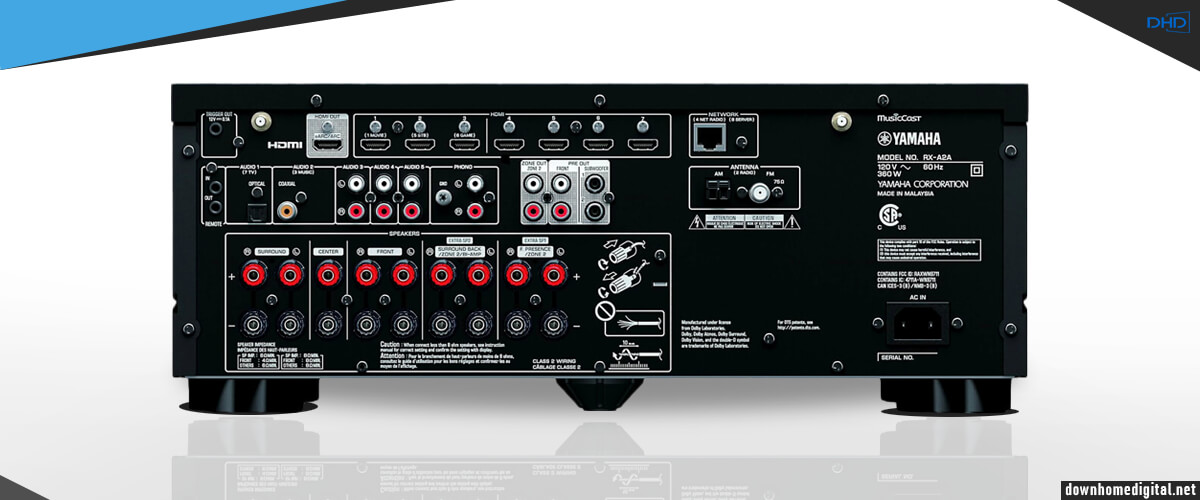
The RX-A2A is a cheaper alternative to the Marantz Cinema 60 as it also has 7 amplification channels. Yet, it doesn’t deprive you of the ability to create a 2-Zone Multiroom broadcast and branded wireless MusicCast Surround system. In addition, there’s an extra subwoofer output to create a 7.2 configuration for fat bass lovers. It has USB ports (and another front), Phono Input (MM), Optical Digital Audio Input, Coaxial Digital Audio Input, and 4 analog inputs. It has 7 HDMI Inputs (4K/120Hz and 8K/60Hz) and 1 HDMI Output (HDCP 2.3, eARC). You can watch HDR10+, Dolby Vision, and HLG HDMI video formats and enhance low-quality content to 4K with Upscaling (not up to 8K like the AVR-X3800H or Cinema 60). The Yamaha RX-A2A decodes Dolby Atmos, Dolby TrueHD, DTS:X, and DTS-HD Master Audio formats, so you’re keeping up with the times.
Of course, you should expect device compatibility with streaming services (Pandora, Spotify, Amazon Music, Deezer, etc.) and voice assistants (Alexa, Google Assistant, and Siri). Left to mention is the presence of Wi-Fi, AirPlay 2, Bluetooth, and an FM/AM Tuner.
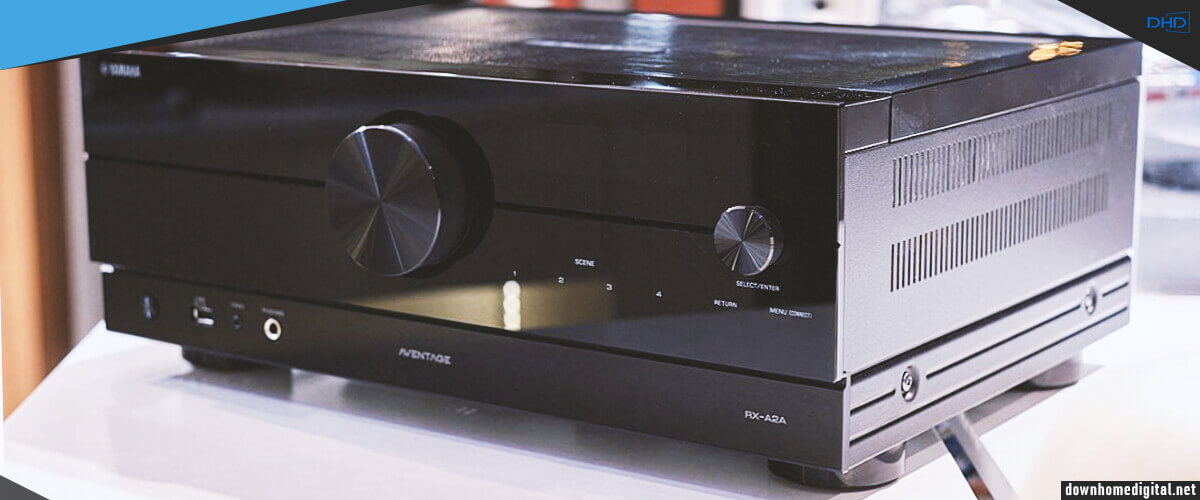
Regarding power, the RX-A2A is inferior to the Denon AVR-X3800H but is on par with the Marantz Cinema 60, offering 100 W (8 ohms, 20Hz-20kHz, 0.06%, 2ch). I’ve already mentioned the specifics of the Yamaha sound; it’s somewhat cold. However, that does not make it worse; the brand also has a huge number of fans because of this sound. I tested the multi-channel device on the movie Free Guy, which has a great soundtrack, including digital sounds, dialogue, and music. The quality is excellent; I had no complaints, and the detail and frequency separation is high. I did notice some sound delay (minor) a couple of times, though. Perhaps this fact is not worth mentioning, but I must mention it. Listening to Spotify left me thoroughly satisfied, and Alexa worked without interruption.
Yamaha RX-A2A is an inexpensive alternative to more prestigious mid-segment models and a nice receiver for home theater. It is inferior to the leader of the selection, Denon AVR-X3800H, in the number of channels and even to the second place of this review – Marantz Cinema 60, in the quality of support for some features. Take, for example, the YPAO calibration system. It can’t match the level of customization without manual intervention with their Audyssey. The mid settings are flat, and I had to spend considerable time trying to extract deeper bass and clearer highs. The video upscaling feature is only possible up to 4K, and the receiver only has 1 HDMI output.
The sound of the RX-A2A is also quite specific and is more suitable for stereo than surround sound. But a lot of people love that crystal clear sound, although objectively, not everyone does. Still, it offers pretty high quality for reasonable money.
| Power |
|
| HDMI features |
|
| Video features |
|
| Network |
|
| Surround sound processing |
|
Pros
- All HDMI ports support 8K video.
- A sufficient number of wired and wireless connections.
- Compatible with streaming services and voice assistants.
Cons
- The glossy surface requires active maintenance.
- Would like to have more HDMI outputs.
- Upscaling to 4K only.
- Rarely, but there is a problem with audio lag.
- YPAO automatic room calibration is significantly inferior to Audyssey (at Denon and Marantz).
- The crystal cold sound may not be to everyone’s liking, and sounds better in stereo.
Best budget receivers
People often mistakenly believe that to assemble a theater system, they need to go literally bankrupt and give up the idea of buying one. In this category, I have collected budget home AV receivers, which, although they have limited options compared to the expensive ones, are still the most popular, high-quality, time-tested receivers. They can provide you with the most important thing – to combine your equipment and provide quality sound when watching video content and listening to streaming services. Even two-channel representatives of this segment with stereo sound will still be the better alternative to a regular TV or soundbar.
Sony STR-DH790 – best budget

The only Sony representative on my list, the STR-DH790, also released in 2018, is a great device for home theater. Unlike the Yamaha RX-V385 (which is not much cheaper at all), it has a 7.1-channel configuration (even 7.2 thanks to the optional subwoofer output), offering us the option to add overhead speakers (in 5.1.2 configuration). But when you compare it to the 7-channel Yamaha RX-A2A and Marantz Cinema 60, it’s obvious that when you pay less, you get less.
One of the reasons Sony makes such inexpensive receivers is the build quality and design, which hasn’t changed in decades. Even paying attention to the weight of 16.6 pounds, it’s safe to say the internal components are inexpensive and won’t last long. This doesn’t mean the AVR will break in a year, but after a few years, its sound will deteriorate. The buttons and controls are also noticeably worse quality, walking around a bit under your fingers. And since there haven’t been any updates in years, the remote also looks like your grandmother brought it in. But wait to flip, you want to consider a budget option, right? Buying a new receiver for you in a few years will not be difficult. And that’s its advantage over expensive ones.
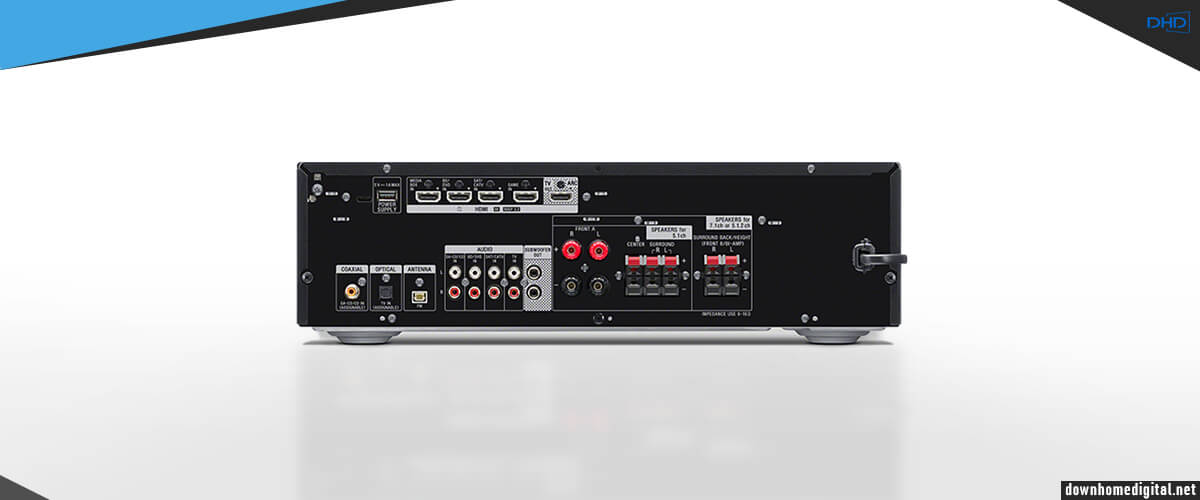
For its price, the receiver has limited connectivity, very similar to the RX-V385. There is 1 Optical Audio Input, 1 Coaxial Audio Input, 4 Analog Audio Inputs, the abovementioned 2 Pre Out Subwoofer and USB (for power supply only, unfortunately), 4 HDMI Inputs (supports 4K and UHD at up to 60 Hz), and HDCP 2.2 Output (eARC). You can watch videos in HDR10, HLG and, Dolby Vision, 3D, Deep Colour.
As for audio capabilities, though, Sony has outdone Yamaha, offering DSD decoding, Dolby Atmos, Dolby Digital, DTS: X, DTS-HD Master Audio, and others. This receiver, like its predecessor, has no Wi-Fi, but it does have Bluetooth and radio (FM only). Simple and limited, but considering its price with acceptable compromises. And compared to the competition, there are even a few nice bonuses.

For testing, I chose The School of Rock with the inimitable Jack Black. The movie’s stunning sound allowed me to ensure the quality sound of the Sony STR-DH790. The sound was incredibly realistic, musical instruments and vocals of the main characters in the surround sound immersed me in watching, making me remember my childhood. Of course, this is not the limit of audiophile dreams, but in general, in conjunction with my equipment, the receiver showed stable quality work. Stereo generally sounds great; even when using Bluetooth, I did not notice outright shortcomings. It should be noted that Sony specifies the power output only for 6 ohm speakers, and it is 145W (that’s about 90W for 8 ohms). But you’d better not turn the volume up to full power because, at 0.9% THD, there will be distortion and noise. So, just accept the fact that your windows are not going to collapse. And at medium power, the sound is pleasant and even quite detailed, as a 7-channel system should be.
Sony STR-DH790 is a great choice for tech-savvy people willing to spend some time tweaking to optimize the performance of one of the best budget AVRs in a home system. Why did it take the first place in the selection? It’s simple. It’s the only 7-channel receiver in the category. It sounds good, but don’t set the volume to max. You can watch movies in 4K quality (not 8K), but with Dolby Atmos surround sound. And if you dislike it in a couple of years, it won’t be a pity to replace STR-DH790 because it’s so cheap. In my opinion, it’s quite a decent option for those who are not obsessed with technology but want ceiling speakers.
Yes, it doesn’t have Wi-Fi, no phono input, and few HDMI ports, but the rest of the category doesn’t have that either. So, should we write those things down as shortcomings? I don’t think so. Just be prepared to get exactly what you give a few hundred bucks for.
| Power |
|
| HDMI features |
|
| Video features |
|
| Network |
|
| Surround sound processing |
|
Pros
- The only one in the budget segment that has 7 channels of amplification.
- Decent sound.
- Bluetooth works fine.
Cons
- No Wi-Fi.
- Few HDMI ports.
- 4K video only.
Yamaha RX-V385 – entry-level AVR
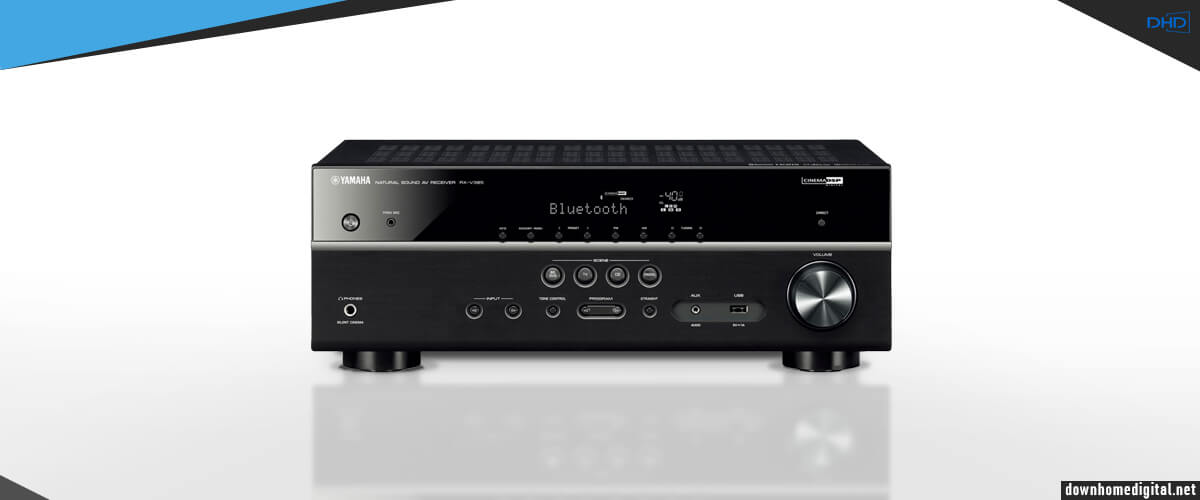
Second among the budget ones, and also the most inexpensive, is the RX-V385, another Yamaha representative on my list (2018 model). The receiver is a 5.1-channel system, and despite some compromises (related to the low price), it offers an optimal selection of options.
As for the quality of construction and design, I personally like the Yamaha RX-V385 better than the Sony STR-DH790. At least, it is prettier, more modern, or something. But when I took it in my hands for the first time, not realizing that the body was soft, I almost left a dent. Keep in mind. Still, the 17-pound weight (more than the 7-channel STR-DH790) speaks volumes about the pretty good internal components. Still, the brand holds the mark, no matter what you say. You can feel it in the details. Buttons and regulators look more reliable, but you can feel plastic in everything when you touch them. Well – it is not strange for the budget segment.
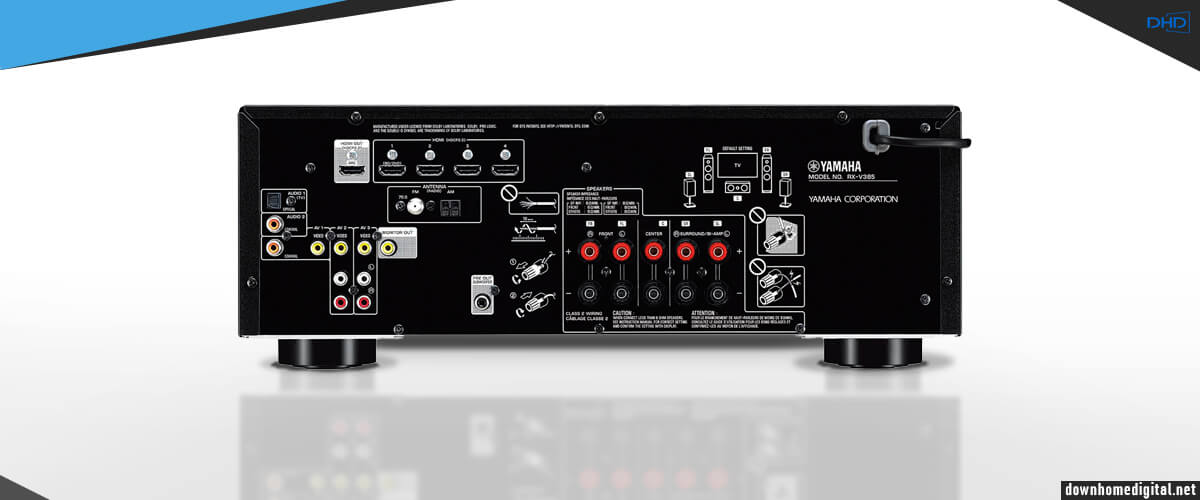
The Yamaha RX-V385 has limited connections, including a USB Input (Front), 1 Digital Optical Audio Input, 1 Coaxial Digital Audio Input, 3 Analog Audio Inputs, and Composite Video jacks (3 Inputs and 1 Output). As you see, there is no phono input, so the connection of a record player is possible, but with an external preamplifier (or turntable with a built-in one). Of course, budget receivers have fewer HDMI ports (Sony STR-DH790 has the same number, for example). And in this case, we have 4 HDMI Input (4K Ultra HD Pass-through, 3D Pass-through, and 4K / 60p, 4:4:4 Upscaling) and 1 HDMI Output (with HDCP 2.3, ARC, eARC), which makes it possible to view content in HDR10, Dolby Vision, and Hybrid Log-Gamma formats. There are as many connections as the 7-channel Sony STR-DH790, which means it’s already pretty good.
As for the sound potential of the receiver, Yamaha has equipped the RX-V385 with exclusive CINEMA DSP technology, which supports such audio formats as Dolby TrueHD, Dolby Digital Plus, DTS-HD Master Audio. And another feature of the device is the ability to place all five speakers in the front. In this case, you will still enjoy surround sound thanks to its virtualization.
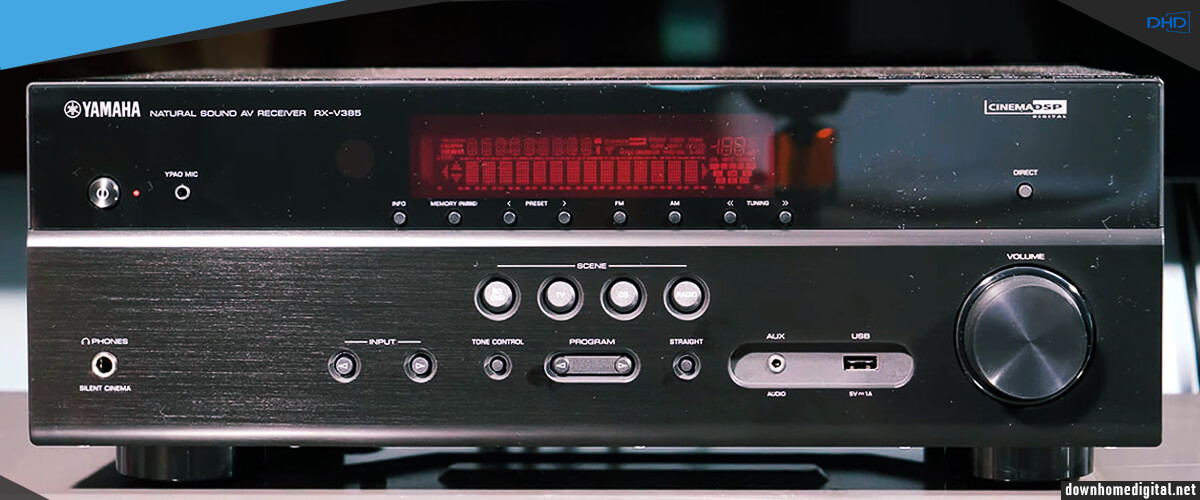
You won’t find Wi-Fi (like the STR-DH790), but Bluetooth lets you use streaming services. You can also listen to the radio, as the manufacturer did not forget to integrate FM / AM Tuner.
This model, like most budget ones, is not very powerful. The manufacturer states the rated power of 70 W (8 ohms, 20Hz-20kHz, 0.09%, 2ch). This is the lowest in the category, but the THD is very good so that you can listen to movies and music at almost maximum. But if you properly set up the system, place it in a small room (as I did in my testing), turn on a good movie (in my case, it was Metal Lords), and sit back in a comfortable chair – I guarantee you the quality surround sound of your home theater. I used the radio to test the stereo sound, and I liked Yamaha’s slightly cool, clean sound.
For the budget segment, I consider the Yamaha RX-V385 one of the best budget AV receivers for the purity of sound, ergonomic design, and good build quality from Yamaha at a very affordable price. But unlike the Sony STR-DH790, it offers only 5 channels of amplification, which means you can forget about Dolby Atmos. I can well imagine this model in a teenager’s room, guest room, or even a bedroom, where there is not much space, but in the evening, you want to watch movies at least approximately with the sound with which the author conceived it.
I have already talked about the cool sound of Yamaha. But in this minimal surround system, it doesn’t sound too specific. Still, besides Bluetooth, you cannot utilize content streaming services. All in all, it is simple and super accessible.
| Power |
|
| HDMI features |
|
| Video features |
|
| Network |
|
| Surround sound processing |
|
Pros
- Build quality is visually and weight-wise better than the Sony STR-DH790.
- Virtualization of sound when there is no possibility to put speakers in the back.
- The number of connections is the same as in the 7-channel Sony STR-DH790.
Cons
- Only 5 channels of amplification.
- No Wi-Fi.
- Supports only 4K video (same as Sony STR-DH790).
- Lowest power in the budget segment.
Denon DRA-800H – stereo
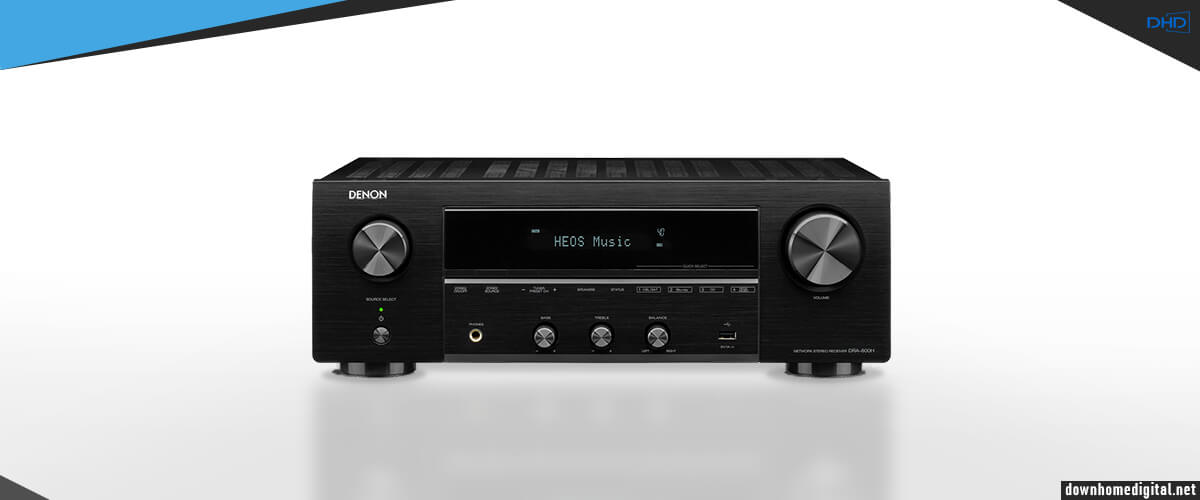
Once again, Denon is on my list. This time it’s the 2019 budget DRA-800H, which differs from the Sony STR-DH790 and Yamaha RX-V385 in that it has only 2 channels. So yes, it’s a home theater amplifier with the capabilities of an AV receiver, which means for almost the same price, you can get something more than the other two, but not surround sound.
Let’s start with the weight, shall we? I always tell you how important it is to know it in advance. So here’s the Denon DRA-800H at 18,3 pounds with only two built-in amplifiers. This exceeds the weight of the STR-DH790 and RX-V385, which automatically means that quality components are installed inside (disclaimer: for the budget segment, compared to other models in the category). The design is nothing new; I’ve already said Denon doesn’t bother with design changes. But I want to note that bass, treble, and balance are regulated not by buttons, as in most budget variants, but by round knobs. They respond quite smoothly in the hand, so the adjustment is more precise.

DRA-800H, as it should be a budget device, has a limited number of connectors. The manufacturer focused on video capabilities and stereo sound. There is the ability to connect two pairs of speakers, and two subwoofers, a phono input, audio separation into two Multiroom Zones, Digital Audio Coaxial and Optical Inputs, also 5 HDMI Inputs with CEC support, ALLM Pass-through, 3D Signal Pass-through, 4K Signal Pass-through 1 HDMI Output (with 4K Capability and ARC Support), and USB. Wireless connections include Wi-Fi, Bluetooth, and built-in HEOS Wireless Multi-Room Technology. It allows you to connect your vinyl player, CD, DVD, Blu-ray players, and game consoles, as well as use streaming services from Amazon Music, TIDAL, Deezer, Napster, Spotify, and Pandora, and use voice assistants (Alexa, Google Voice Assistant, and Apple HomePod), which sets it apart from the Sony STR-DH790 and Yamaha RX-V385. And, of course, watch videos in HDR10, HLG, and 4:4:4 color resolution. Or just listen to the radio via AM/FM Tuner.
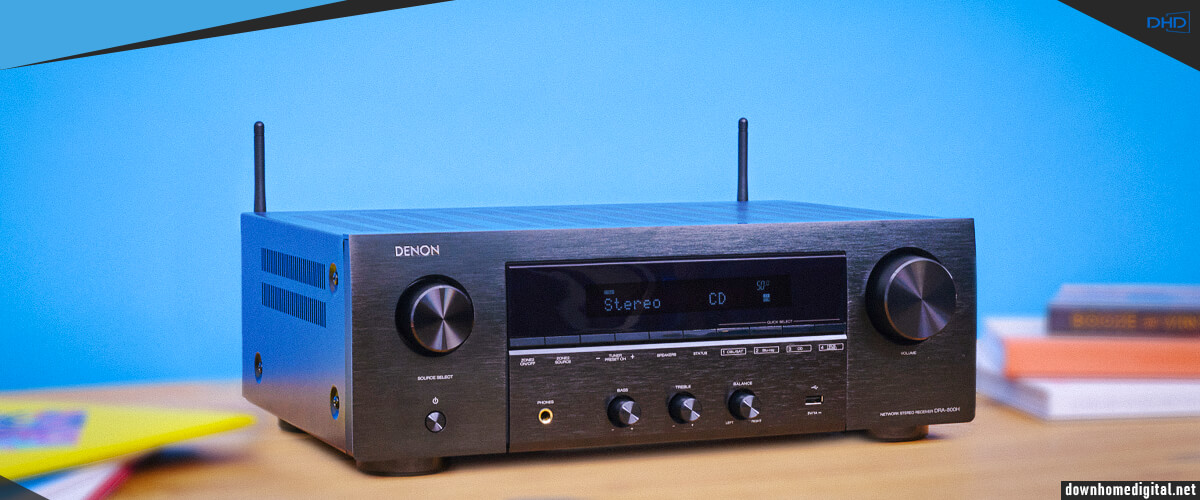
Given the lack of surround sound, I tested the movie in stereo, keeping the tradition for this category of receivers and choosing the musical A Star Is Born with the inimitable Bradley Cooper and Lady Gaga. As always, Denon sounded warm and clean, with no lag or noise. Of course, as expected, this model has more power than the other two. The manufacturer’s rated wiring is 100 W (8 ohms, 20 Hz – 20 kHz, 0.08% 2ch Drive) and 120 W (6 ohms, 1 kHz, 0.7% 2ch Drive), but I don’t recommend using full volume.
I also tried the turntable with a Nirvana record. There was great detail on Kurt’s vocals, deep, languid lows, and I could feel the musicians strumming the guitar strings.
If you want to have a high-quality picture of modern content and listen to high-quality stereo, the Denon DRA-800H is a more-than-worthy choice. It really is the best dual-channel amplified AV receiver you’ll find, as the model has HDMI inputs (for 4K video) and is essentially a hybrid. You’ll also find it offers plenty (much more than the Sony STR-DH790 and Yamaha RX-V385) of connectivity options for wireless devices, and you’ll also be able to control the system with voice assistants (something the competition also lacks).
The only drawback of the DRA-800H is that it doesn’t have a multi-channel surround sound system. But it’s the most powerful in the category, though it can sometimes fizzle a bit at the limit. Still, I trust Denon more; I talked about the brand’s quality when I described the leader of the whole review.
| Power |
|
| HDMI features |
|
| Video features |
|
| Network |
|
| Surround sound processing |
|
Pros
- Warm analog sound with good detail.
- The presence of many connection options for music.
- There are HDMI ports with 4K signal processing capability.
- Wireless features for using streaming services and voice assistants.
- Ability to connect two pairs of speakers and two subwoofers.
Cons
- There is no surround sound, only stereo.
- Little background noise at maximum volume.
Best premium receivers
Needless to say, the representatives of this category are the most expensive and simultaneously allow you to enjoy all the features of a modern home theater fully. They have more channels, allowing you to build a full-fledged surround sound system even in large rooms. Also, these receivers support Multi-room audio for 3 – 4 Zones, making them optimal exactly for larger homes. Moreover, they have many connections and advanced configuration ports to connect various devices, including old or new appliances, game consoles, players, turntables, etc. Devices in this segment provide support for all kinds of modern surround audio formats (Dolby Atmos, DTS:X and their configurations) and high-quality video (8K/60Hz or 4K/120Hz in HDR, Dolby, 3D and IMAX formats), allowing you to keep up with the times, using streaming services and voice assistants of all kinds. And, of course, the clearest sound possible at high power.
Marantz SR8015 – best premium
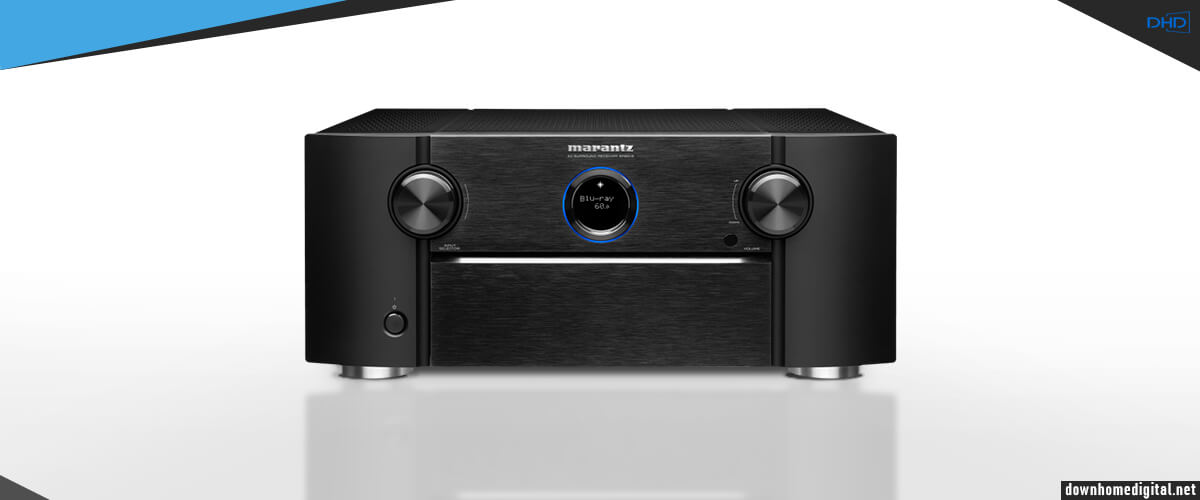
If you are interested in top-rated AV receivers, you must have a big house because the 11.2 channel Marantz SR8015 will need a big room (just like the second member of this premium segment Denon AVR-X6700H, but I’ll tell you about it a little later). Released in 2020, the model with a hinged front cover, behind which the control of basic functions is hidden, looks modern, but the main “beauty” is on the rear panel.
First, it is worth noting the possibility of expanding the system up to 13 channels, thanks to the possibility of connecting an additional stereo receiver. Thus, you can enjoy the full possibilities of surround sound using overhead speakers to build a 5.2.6 or 7.2.4 system for Dolby Atmos. As well as broadcast audio to 3 Zones. If you have a large family with different preferences – having a scandal-free evening is no problem now.
SR8015 looks modest, understated, and even simple, but you can’t help but feel that chicness. It is clear that you can (and should) expect something amazing for its price, but still, the quality is amazing. The metal is treated as if you’re holding a handmade jewelry chest. The weight of the receiver – 38.4 pounds – also hints at this. It’s unbreakable and will serve you, your children, and your grandchildren. And with the same quality as the first week of use. There are expensive components inside this machine, and gold-plated RCA connectors are another thing that affects signal transmission quality. All the buttons are sensitive exactly as required, with no pressure, no clicking, just a delight for those who understand good technique. Released in 2020, the model with a hinged front cover that hides the main function controls looks luxurious. Even the small round screen here doesn’t annoy me too much because there’s a full-size LCD hidden under the cover. But the main “beauty” is on the back panel.
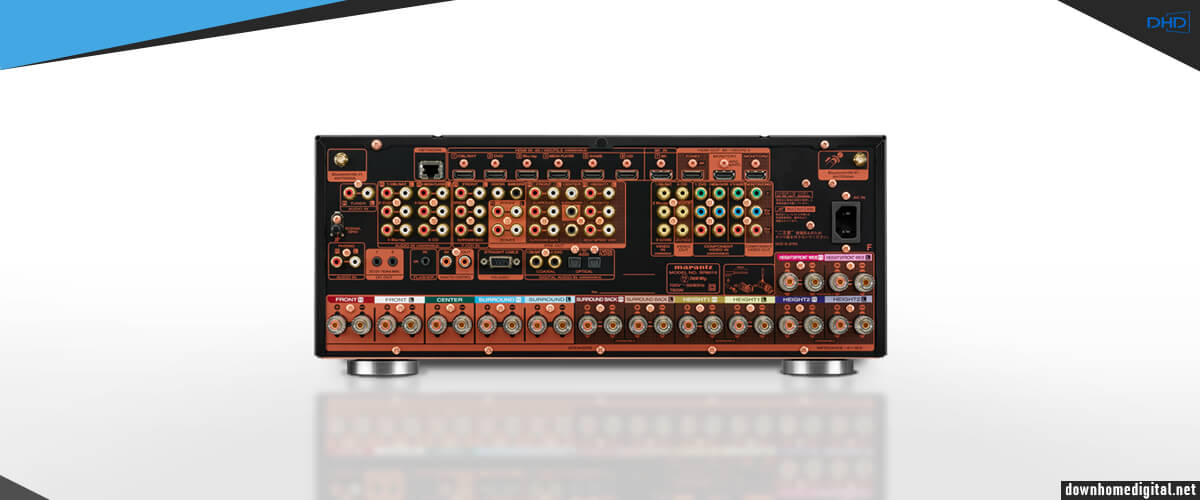
The SR8015 has an amazing number of connections (much more than Marantz Cinema 60 has): Composite (5 Inputs and 2 Outputs), Component (3 Inputs and 1 Output), 7 Analog Inputs, 2 Optical and Coaxial Digital In, Phono (MM) In, and as you can see from the description above, 2 Subwoofer Outputs. As a result, all your old and new equipment will no longer be lying in the attic or boxes but will take its rightful place in your home system. The number of HDMIs is also impressive. The receiver has 8 HDMI inputs (Scaling up to 8K/60Hz, 3D Signal Pass-Through) and 3 HDMI outputs (CEC, eARC) for HDR, Dolby Vision, HDR10+, Dynamic HDR, and HLG video viewing at 8K/60Hz or 4K/120Hz and advanced gaming (ALLM Pass-through, VRR, etc.). But 8K is only available on 1 of the inputs.
Its audio capabilities are also excellent. The Marantz SR8015 decodes DTS HD Master, DTS:X Pro, DTS Neural:X, DTS Virtual:X, Dolby TrueHD, Dolby Atmos, IMAX Enhanced, and Auro 3D. Of course, it lets you listen to Hi-Res Audio, use streaming services (Spotify Connect, Pandora, SiriusXM), voice assistants (Alexa, Google Voice Assistant, Apple HomePod), and has AirPlay2, TuneIn Internet Radio and HEOS Multi-room and Streaming system built in. I had no qualms about finding Wi-Fi, Bluetooth, and an AM/FM Tuner in it. Impressed? I’m not. I’ve seen the Marantz SR8015’s price and couldn’t have expected less.
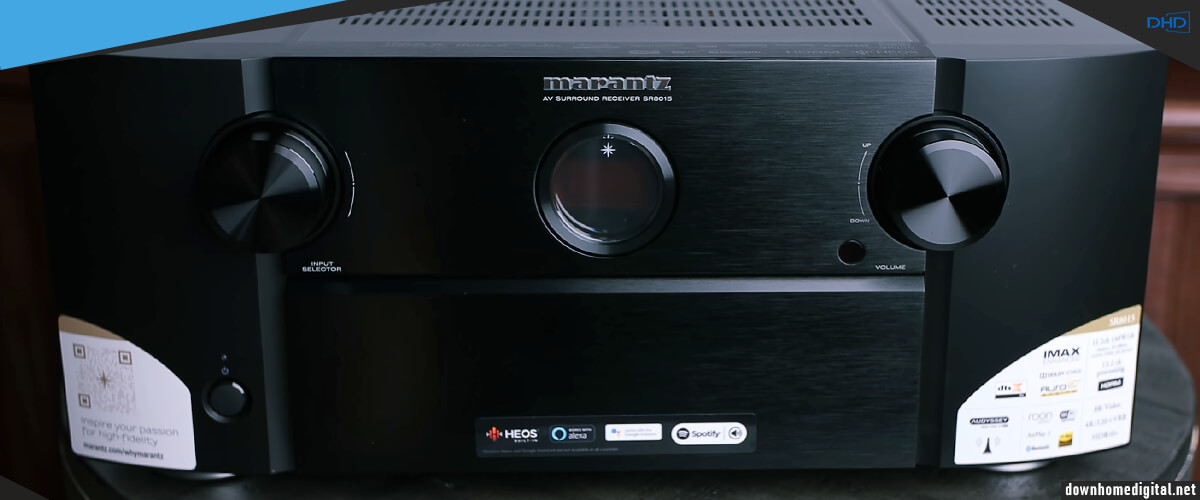
The power capabilities of this model are also astounding like they should be; if you remember, we’re talking about a large room. The manufacturer wilts 140 W (8 ohms, 20 Hz – 20 kHz, 0.05% 2ch Drive) or 175 W (6 ohms, 1 kHz, 0.7% 2ch Drive), and I am happy with the THD (much better than Marantz Cinema 60). An inexpensive receiver will not give that kind of clarity at high power. To test such a receiver, you need to pick up dynamic movies, I decided, and settled on Shang-Chi and the Legend of the Ten Rings of Marvel. The clang of metal, the sounds of stunning nature, the flight of the Dragons, and the fight scenes make you experience the movie as if you were directly inside the picture. It’s a great experience. Quiet scenes and dialogues are heard clearly and in detail. In stereo, the receiver proved monstrously powerful (I tried playing with a Muse record and Deezer wirelessly), making every vein of my body dance.
The Marantz SR8015 is truly the best receiver for creating a stunning surround-sound home theater in a large room. Its many features and capabilities are well worth the money spent on it. But the main advantages are inside it. The technology and components used in the design are amazing, and this model will be a great investment in the future for years and even generations to come. Well, you’ll have to shell out a hefty sum, including a selection of quality speakers. The SR8015 sounds simply superb. All the models described above pale in comparison, but that’s how it should be. After all, the bigger the system, the more it allows you to separate sound layers, creating the most realistic picture. Even with two subs, the receiver has enough power and bass.
Still, it has its drawbacks. Only 1 HDMI input is designed for 8K video. And I’d update the UI menu system if I were Marantz. But all this is a tribute to the year of release (2020). More modern devices cost more, keep in mind. I think the SR8015 data is quite sufficient, especially since you can divide the channels into 3 zones (useful if you have a family with different evening preferences).
| Power |
|
| HDMI features |
|
| Video features |
|
| Network |
|
| Surround sound processing |
|
Pros
- It makes a great clear sound at high power.
- Adding an optional stereo receiver expands the configuration to 13.2 channels.
- A large number of wired connections for old and new equipment.
- Support for almost all existing formats of the highest quality audio and video.
- Built-in wireless ecosystem and streaming services.
- Audio can be divided into 3 zones.
Cons
- Only 1 HDMI input supports 8K video.
- The user interface menu system needs to be updated.
Denon AVR-X6700H
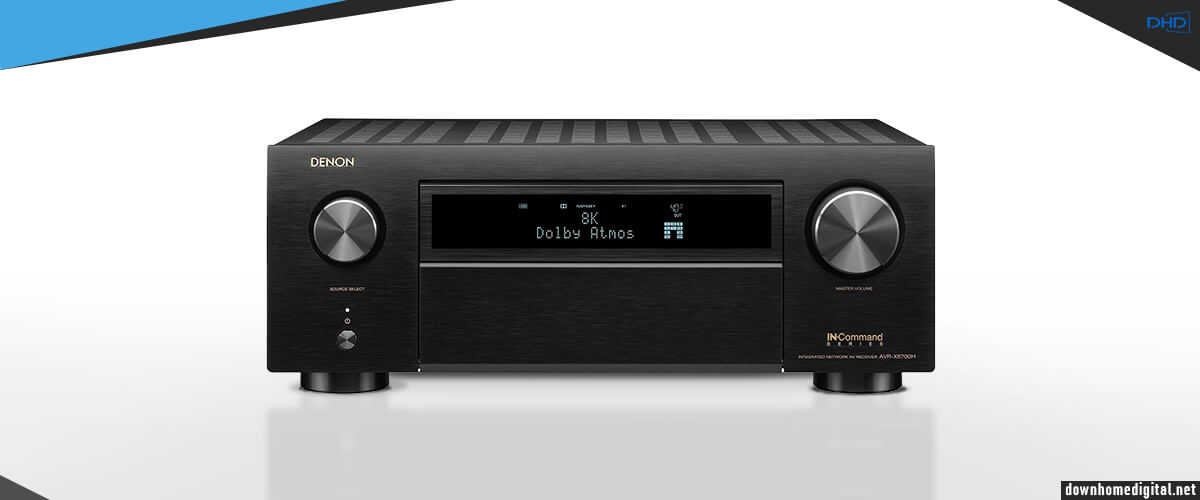
You might laugh, but the Denon AVR-X6700H and Marantz SR8015 are almost identical in their options. The X6700H, also released in 2020, also has a hinged cover to protect the main front panel controls and is also an 11.2-channel surround sound receiver with an expandable configuration to 13.2 with an optional receiver (allowing for 5.2.6 or 7.2.4 systems). And the AVR-X6700H has a rectangular LCD as opposed to the round one on the SR8015. But the difference is very noticeable if you compare X6700H and X3800H, also presented in this review.
The AVR-X6700H once cost as much as the Marantz SR8015 does today. But the cost of one and the other has been reduced as time marches on, and some features are considered obsolete (this mainly refers to the fact that the receivers only have 1 HDMI input that supports 8K resolution video). The AVR-X6800H has replaced the AVR in question, which aligns more with modern video requirements. But there are no claims to the quality of construction. This model can also serve for a very, very long time. The processor, chips, connectors, and control buttons are made with such care for the user that if I were to choose between two models, I would definitely choose this one. Well, because I don’t see the point of paying for a name, I realized Denon’s advantages in this sense long ago.
I don’t even know if it’s worth describing the connections because they are the same as the Marantz capabilities. I’ll try to shorten it. So, Multiroom for 3 Zones and HEOS Built-in for wireless audio to other rooms are there. By the way, maybe Denon is always a little cheaper for similar models to the Marantz, partly because HEOS is a native development of the former and is almost always used in the latter. You can also connect “everything to everything” thanks to a wide variety of jacks: old equipment (Component and Coaxial Inputs), a vinyl player (Phono Input), a CD player, Blu-ray DVD, video console (Xbox, PS, Nintendo) and more. There is Wi-Fi and Bluetooth. Like the Marantz and more than the Denon AVR-X3800H, the number of HDMI ports (8 inputs with HDCP2.3 support, high-definition video, Upscaling, and 3 outputs (including CEC and ARC/eArc)).
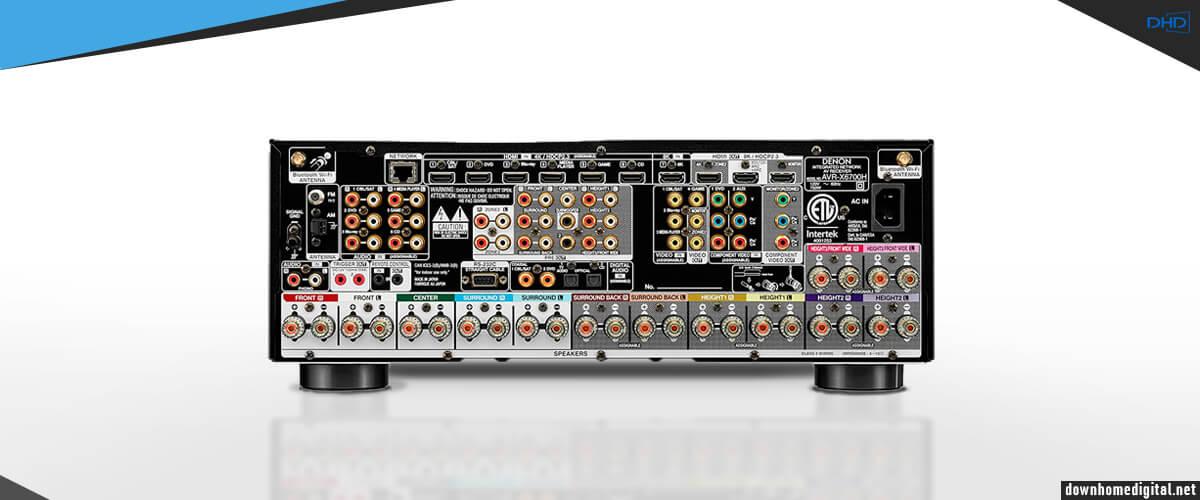
So 8K 60Hz or 4K 120Hz video is available for Dynamic HDR, HDR10+, Dolby Vision and 3D video formats, and Dolby Atmos, DTS:X Pro, DTS Neural:X, IMAX Enhanced, and Auro-3D audio decoding (I found the difference: Denon does not decode DTS Virtual:X, if that matters to anyone). Hi-Res Audio, streaming services Spotify, Deezer, Apple Air2, and others, and voice assistants are also available.
Regarding sound quality and power, the Denon AVR-X6700H is as good as the Marantz SR8015 but gives much better THD than the Denon X3800H. So, it seems that the choice between the two representatives of this category comes down to which brand you are in the army of fans. After all, for all their similarity, the receivers sound different because the manufacturers strive to maintain uniqueness.
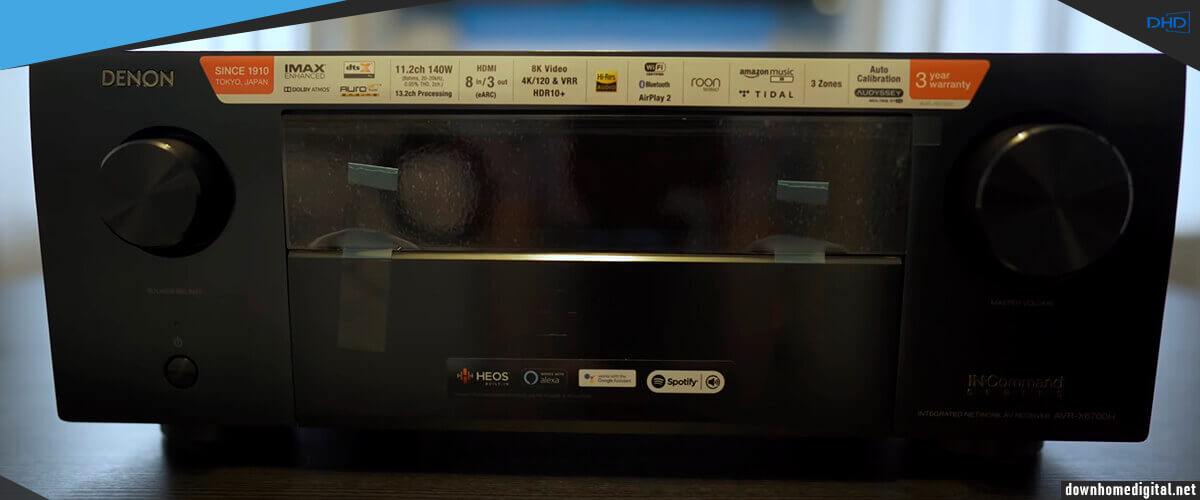
I also chose Marvel for testing, but it was Captain Marvel this time. The power made me shake and flip in my seat (I must say, I have great speakers), and the “movement” of the sound was as if sometimes it went through me. Top-notch. I also have no complaints about the stereo on the vinyl player (Kiss record) and Pandora. The cleanest tops, deep fat bass – everything is in its place, and I want to enjoy the quality again and again. But without using subs, the Denon has less bass (so choose wisely), and I always check the receiver’s “clean” sound. Also, when switching sources, I noticed infrequent but distorted images.
Denon AVR-X6700H offers excellent features thanks to modern technology, build quality, and high-end sound and deserves the title of the best AV receiver. It is slightly inferior to the Marantz SR8015 in bass level without additional equipment, but this is unlikely to be an important factor for the unsophisticated viewer. For me, the combination of price/quality matters, and my choice is obvious (take at least the leader of my selection – also a representative of Denon, model X3800H).
The lower cost of the receiver with the same input data is because, in the case of Marantz, you always pay for the name (as, for example, with Louis Vuitton). But the essence and the quality of signal transmission (performance in general) of Denon are not much lower than those of the high-end brand. However, I did notice some minor delays when switching sources. If this had happened with Marantz, I would have had a scandal with customer service.
| Power |
|
| HDMI features |
|
| Video features |
|
| Network |
|
| Surround sound processing |
|
Pros
- Powerful, clear sound in stereo and excellent surround sound.
- The possibility of adding a stereo receiver expands the configuration up to 13.2 channels.
- Wide range of connectivity options for old and new equipment.
- Support for almost all existing formats of the highest quality audio and video.
- Built-in wireless ecosystem and support for streaming services and voice assistants.
Cons
- Switching from one source to another may cause image distortion.
- The bass power does not match the high volume of the middle and high registers.
You may need it
It’s not just the receiver that’s important in an audio system, although it is the backbone. The result of what you hear depends on all the components, and it’s important to choose them carefully. So, in this section, you will find a list of equipment that I can recommend to you for assembling a high-quality audio system, as I have tested each of them, and some of them I use myself.
- Stereo speakers:
- Floorstanding: Dali Oberon 5, Klipsch RP-280F, KEF Q950
- Bookshelf: Klipsch RP-600M, KEF Q350, Fluance Ai61
- Speakers kit: Klipsch Reference R-26FA 7.1 Home Theater System
- Speaker cable: Monoprice Access Series
- Stand for AV equipment: Sanus Heavy Duty Stand
AVR buying guide
In this chapter, I will briefly review what I think are the most important features and capabilities of receivers that you should pay attention to before you buy so that you can understand what parameters are optimal for you. I also recommend that you read our big extended buying guide.
How to set a budget for your AV receiver?
The first thing you should decide before you buy is the budget you are willing to allocate. What you need to understand in the context of this question clearly:
- Buying an expensive premium receiver is unnecessary to get “good” sound. Often it will be enough receivers from the average price category or budget for beginners in the home theater world.
- You must remember that to achieve the super-sounding audio/video system, it is necessary that all its components be approximate of the same “level”, which means that if you have a set of stereo speakers for about $1000, it is reasonable to choose a receiver in approximately the same price segment – about $1000 – $2000. Also, if you have, for example, an entry-level 5.1 surround sound system for $300, bought at the nearest video store, then buying a receiver for more than $500 – 600 is not reasonable.
- Of course, the more expensive the receiver is, the more functions and features it has to offer. Let’s look at what they can offer in our buying guide below.
We’ve also highlighted the top models in each price segment:
- List of best AV receivers under $1000.
- List of best AV receivers under $500.
- List of best budget receivers.
- List of best premium receivers.
How many channels do I need?
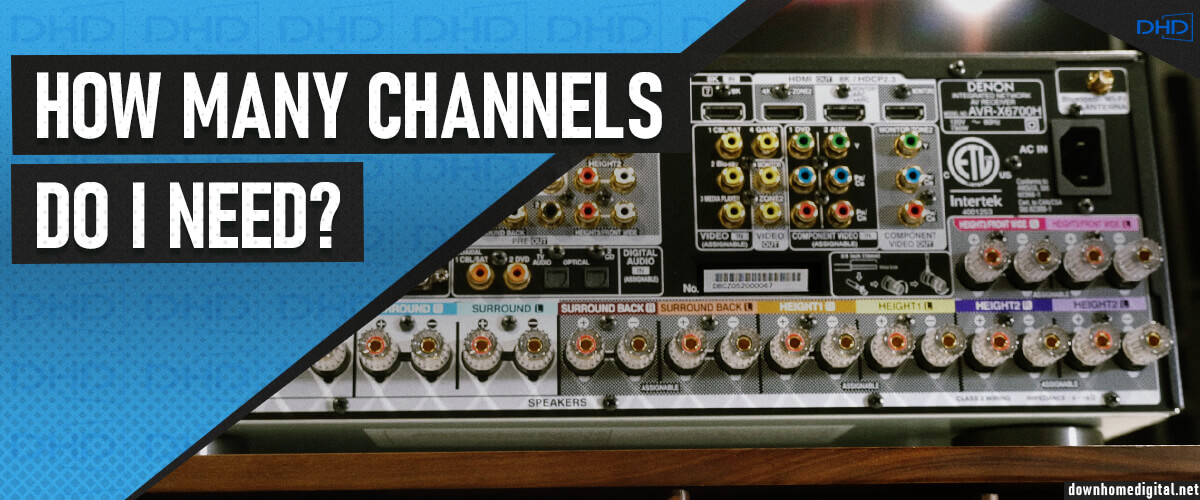
How many channels you need depends on your sound preferences, room size, and budget. It is an important decision because it determines what you can get in the end. Of course, more channels give you the prospect of further upgrading your audio system, which means the receiver will last longer.
2-channels
2-channel receivers, or stereo receivers, are designed for listening to music. Of course, you can watch movies or programs from TV and other devices with them, but without surround sound. In any case, the sound will be better than an ordinary TV or soundbar.
We have made a selection of the best stereo receivers.
5-channels
5-channel receivers are a budget option, consisting of a center speaker (located under the TV), two front speakers (left and right) and two surround speakers (left and right), and one subwoofer (separately for bass). It is the most suitable system for a small room.
We’ve compiled a list of the best 5-channel receivers.
7-channels
7.1-channel receivers are often representatives of the mid-price segment and essentially represent the same configuration as the 5.1, but with the addition of two overhead (high-rise) speakers, forming a 5.1.2 system. This sound distribution is minimal for Dolby Atmos. The 7.1 system is great for medium-sized rooms (about 40m2).
We have selected a list of the best 7-channel receivers.
9-channels and higher
The 9.1-channel receivers also represent the mid-priced segment. This configuration comprises one center speaker, two front speakers, two surround speakers, two ceiling speakers, and two surround back speakers (SBL and SBR). These receivers allow you to create 7.1.2 (with two ceiling speakers) or 5.1.4 (with four surround channels) configuration systems, which are optimal for Dolby Atmos audio format.
We’ve selected a list of the best 9-channel receivers.
11 and 13-channels
11 and 13-channel systems are an advantage of premium units that allow you to build a 7.1.4 (and other) full Dolby Atmos configuration. It is the same 9-channel system with additional ceiling and surround speakers. Receivers with this multi-channel capability can provide great sound for a large room and have full multi-room audio support.
We’ve compiled a list of the best High-End receivers.
How much power per channel do I need?
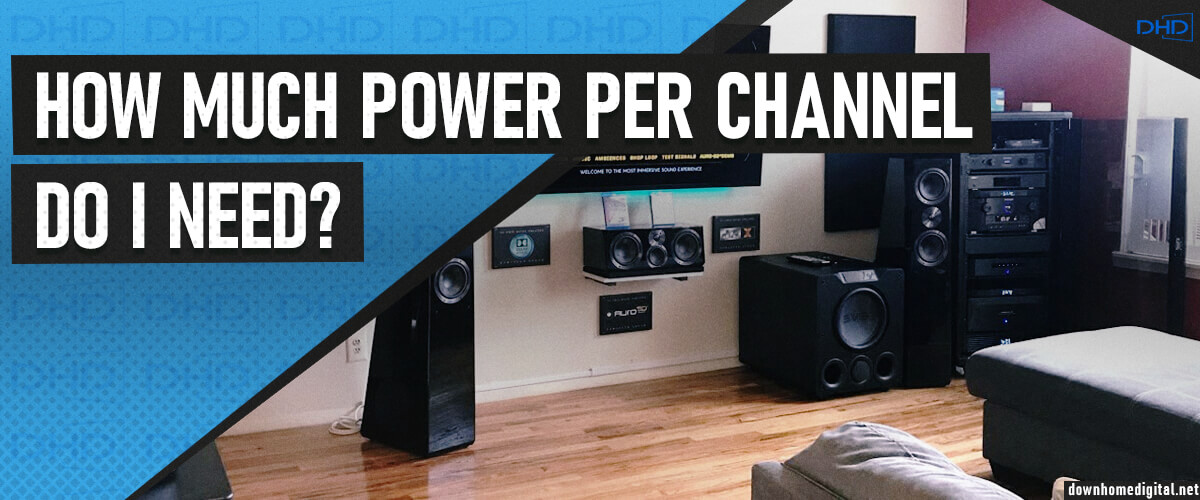
How much power per channel you need depends only on the size of the room in which you place your home system. Therefore, you don’t need a lot of power for small rooms, and vice versa for larger ones. In addition, it is important to know that modern movies contain many soundtracks recorded at different volumes. So if you want better sound quality and not mixed in one pile – choose high power with a good THD.
However, I don’t think this criterion is too important when choosing a receiver because the human ear can catch the difference only when the volume goes down (up) twice. Instead, I recommend paying attention exactly to the distortion indicator because the manuals usually specify the power only for two channels. When you distribute it to 5 or more channels, these indicators decrease.
It’s worth noting that budget receivers usually have less power. But even if the manufacturer states high ratings, you won’t be able to take full advantage of them because THD will usually suffer, and you will hear noise and distortion.
Read more about Understanding The Power Ratings In AV Receivers And Amplifiers here.
What connections do I need?
The connections you need are among the most important criteria when choosing a receiver. It would help to consider what devices will be connected to your home system.
You may need Optical, Coaxial, Composite, and Component inputs if you have a lot of outdated but quality and expensive equipment. For example, RCA inputs, also referred to as analog, are used to connect CD players or cassette decks. And if you are an avid audiophile and have a vinyl player, the presence of Phono input will be excellent. However, don’t buy a more expensive receiver just because of it. You can connect the turntable through any Line In (Line In, Aux, etc.) if you have an external preamplifier.
If you are building a home theater system, consider the number of speakers you have. The receiver often has an additional output for a subwoofer, the ability to connect speakers in pairs, and an additional stereo receiver to expand the system. Also, look out for a headphone jack if you like privacy.
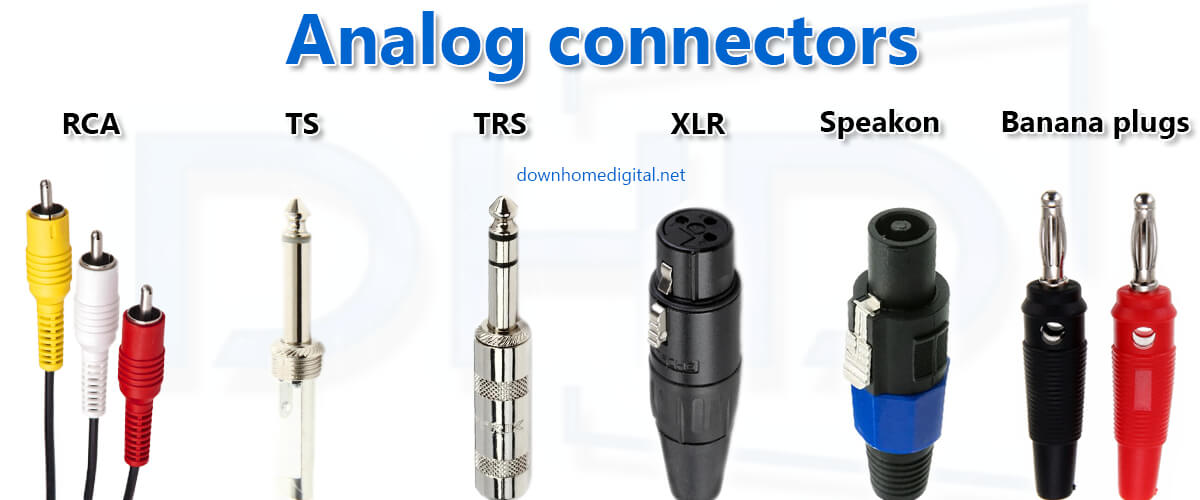
Digital connectors include USB and HDMI; here, you must pay attention to their configuration. If you want to use the USB input as a stream of content from other devices, make sure that the connector allows this (it often happens that such a connector only can recharge your devices). HDMI inputs and outputs are probably the most important ports because their configuration determines the quality of video content transmission.
There may be other connectors as well. Such as Ethernet (for streaming services), XLR balanced (to eliminate noise), and Digital Coaxial and Optical inputs (for TV audio and game consoles).

What video capabilities of the receiver to pay attention
If you want to keep up with the times, you should pay attention to such video capabilities as the ability to transmit video with 4K/120Hz resolution because it is becoming increasingly popular (you can find more and more content with this quality on popular video sites). You can also buy receivers that support 8K/60Hz video resolution and High Dynamic Range formats, of which there are four to date. These are HDR10, HDR10+, HLG, and Dolby Vision. They provide the highest fidelity of light transmission, resulting in a brighter, more sharply detailed picture. And while there isn’t much of this content yet, buying a receiver with support for all possible types will allow you to use it for years rather than changing it over time.
But remember, it’s important that your TV also supports all of these video features. Otherwise, no matter the receiver’s potential, you won’t see the results on your screen.
We’ve compiled a list of best 4k receiver.
What is multi-room audio?
Multi-room audio is the ability to share an audio signal and broadcast multimedia to multiple locations. For example, it allows you to broadcast audio from different TV channels live (simultaneously) to different rooms. That can be very useful if you have a large family with different preferences. But also useful if you want to connect speakers in different rooms, e.g., the living room and bedroom or the dining room.
Multi-room audio is an advantage of mid-range (usually 2 Zones) and premium receivers, with the latter having more zones (3-4 Zones).
DTS:X and Dolby Atmos: Do you need them?
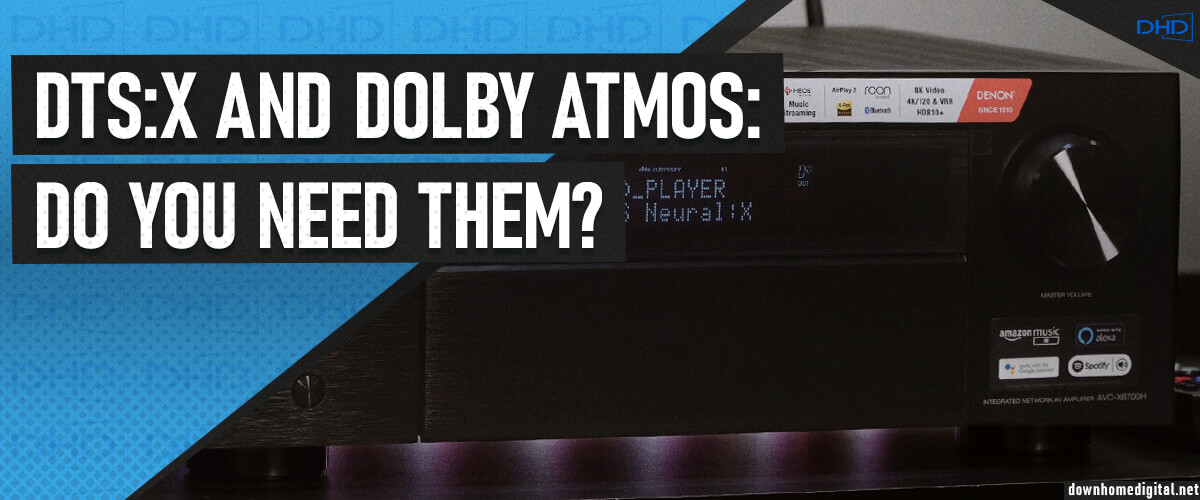
To briefly answer whether you need DTS:X and Dolby Atmos – of course, you do. The modern world dictates its own rules in the development of technology, and today these two surround sound codecs are the most common and relevant. Virtually all movies today are released using these formats, and movie platforms are adding more and more such content.
DTS:X and Dolby Atmos are very similar and under normal circumstances. The only difference is that Dolby Atmos requires ceiling (high-rise) speakers, and DTS:X has a higher bitrate, but the difference is almost unnoticeable. It is also worth mentioning that both formats are only available in configurations from 7.1 (minimum system) and higher (11 and 13.1 are optimal for Dolby Atmos).
You can read more about them and their configurations here.
We’ve compiled a list of the best Atmos receivers.
Which brand of receivers should I choose?
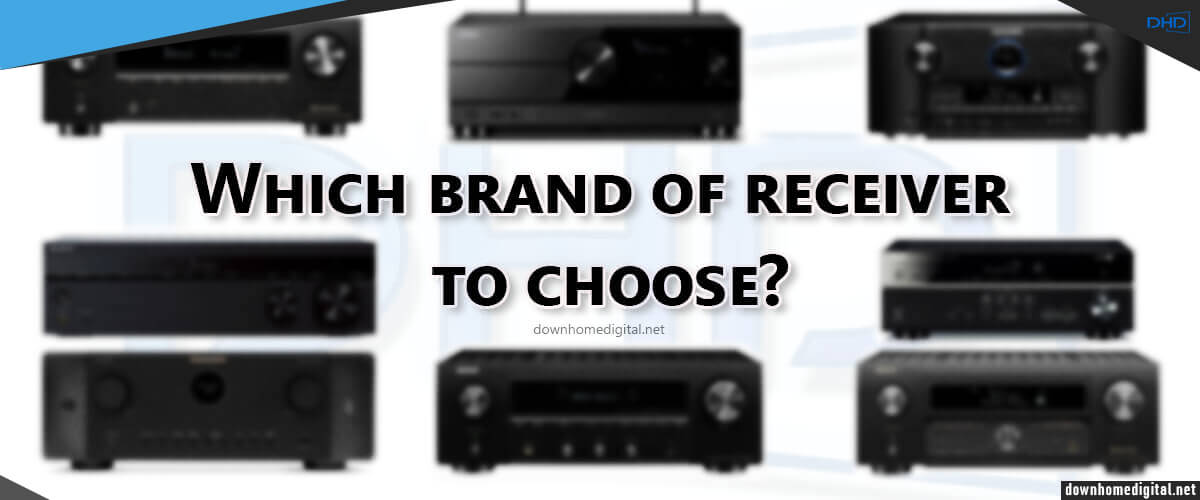
There is no single answer to which receiver brand is the better choice. Today in the market, there are many manufacturers of quality devices with a wide range of configurations, wired and wireless connectivity, and price. Each brand tries to distinguish itself by the uniqueness of the “signature” sound (in reviews, you can often find frequent references to “warm” Denon or “cold” Yamaha, etc.) but invariably try to make it qualitative. Ultimately, choosing a brand comes down to your visual, auditory, and financial preferences and what kind of system you are putting together, that is, from the devices you already have or are about to buy. So before you buy, I recommend listening to the receiver that suits your features and budget.
We have highlighted the best models from each manufacturer at the moment:
- List of best Denon receivers.
- List of best Marantz receivers.
- List of best Yamaha receivers.
- List of best Onkyo receivers.
- List of best Pioneer receivers.
- List of best Sony receivers.
And also compared some with each other:
- Marantz vs Denon receiver comparison.
- Marantz vs Yamaha receiver comparison.
- Denon vs Yamaha receiver comparison.
- Denon vs Onkyo receiver comparison.

